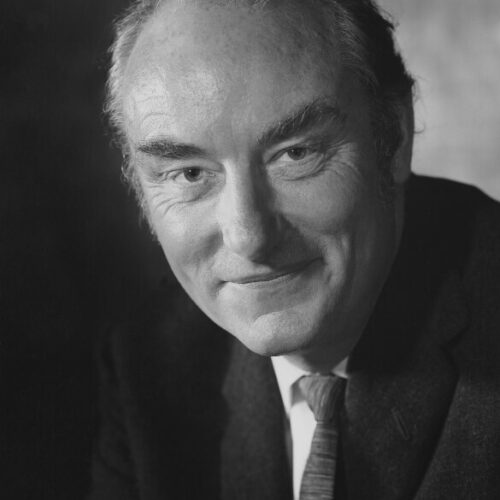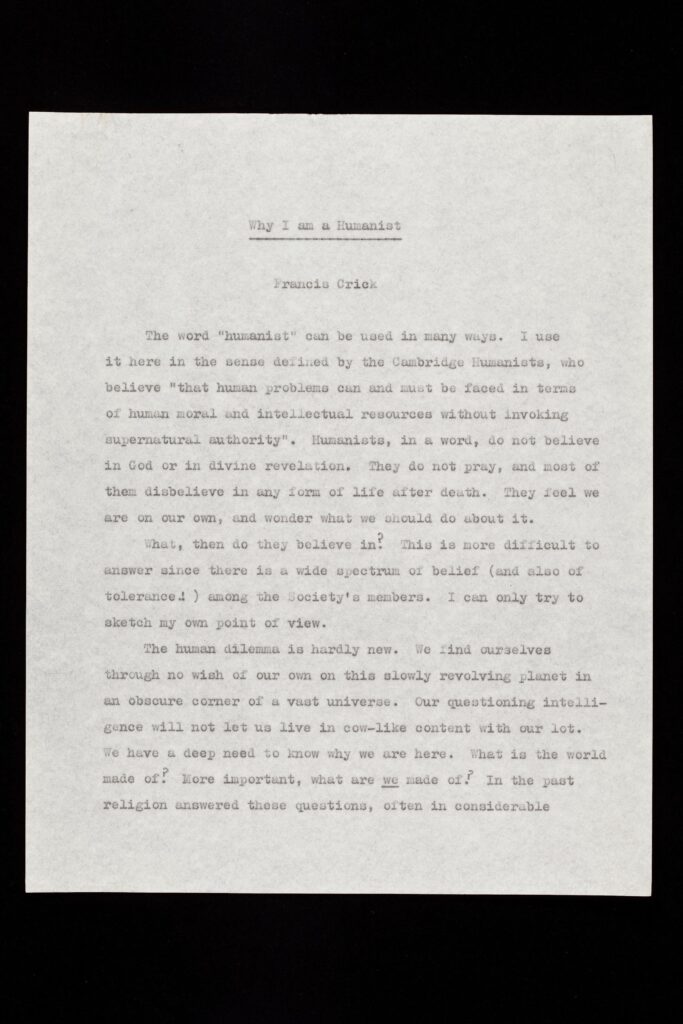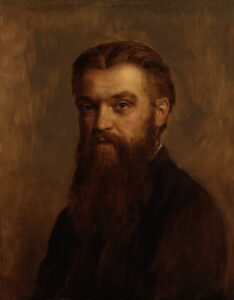

Francis Crick discovered the structure of DNA, the biological molecule of hereditary information, and cracked the genetic code by which DNA codes for proteins. For these achievements he won the Nobel Prize for Physiology or Medicine, with James Watson, and Maurice Wilkins, in 1962. Sceptical of religion from an early age, he was a supporter of humanism, and a catalyst of scientific research in many areas, including, later in his life, studies on the biological basis of human consciousness.
Francis Harry Compton Crick was born in 1916, in Northampton, to Harry Crick and Annie Wilkins. An inquisitive and talkative boy, some of the questions he asked – such as ‘What is water made of?’ arose in his later work. His original PhD at Cambridge was on the viscosity of water above 100C. The question ‘Can chemistry build up life?’ stayed with him throughout his career.
After Mill Hill School, he studied Physics at University College London from 1934-7. The war interrupted his PhD, and he worked for the British Admiralty, at Havant, on improving the British mine laying program, putting it ahead of the Germans. Here, his flair for collaboration and organisation, and a capacity for inventiveness and lateral thinking, marked out his working style.
In 1940, he married Doreen Dodd at St Pancras Register Office. They had a son Michael but were divorced in 1947. While at Havant and working for naval intelligence, he became interested in how non-living chemicals made up living organisms, an interest rooted in his scepticism about religious beliefs. Schrodinger’s book What Is Life? was favourite reading. In 1947, Crick moved to the Medical Research Council Unit at the Strangeways lab in Cambridge, to work on the physical nature of the cytoplasm. He then became interested in protein chemistry and, in 1949, moved with the MRC unit to the Cavendish laboratory, where he started work on the molecular structure of haemoglobin and myoglobin. The same year, he married Odile Speed at Kensington Register Office. They had two daughters, Gabrielle, and Jacqueline.
Crick’s boss at the Cavendish was Max Perutz, who had proposed a structure for haemoglobin, which Crick improved on. Around this time, he was influenced by Linus Pauling’s publication of the structure of the alpha helix of collagen. The collagen structure had been elucidated using a physical model of atoms and bonds, a way of working that Crick appreciated. Crick, in collaboration with others, used Fourier theory to derive features of the X-ray diffraction pattern of helical molecules in fibrous substances. He was also influenced by the arrival in 1951 of James Watson, a young American scientist, who believed that the hereditary material was DNA, not protein.
The stage was set. A paper entitled ‘Molecular Structure of Nucleic Acids: A Structure for Deoxyribose Nucleic Acid’ was published by Watson and Crick in Nature on 25 April 1953. The DNA molecule was proposed to be a double helix of two antiparallel ribose sugar-phosphate chains wound around one another. Between the chains were four nucleotide bases in a strict pairing scheme: adenine with thymine, cytosine with guanine. A second paper in Nature on 30 May 1953, ‘Genetical Implications of the Structure of Deoxyribonucleic Acid’, expanded on how base-pairing made the chains complementary and provided a copying mechanism. Amidst this excitement, Crick was awarded his PhD in 1954 on X-ray diffraction: polypeptides and proteins. He later worked with others to establish the genetic code: how sets of three nucleotide bases in DNA coded for an amino acid. In 1962, he received the Nobel Prize for Physiology or Medicine with James Watson and Maurice Wilkins.
Crick settled at The Salk Institute, La Jolla, California, for his final change in research direction. Here, he collaborated with scientists from many disciplines on experimental tests of the visual system, with the aim of establishing a way of addressing the neural correlates of human consciousness.
For Crick, it was science, and not religion, that explained many of the mysteries of the world. He showed how the Central Dogma of Molecular Biology worked: DNA makes RNA makes protein. He gave lectures to the Cambridge Humanists and was a supporter of the British Humanist Association. He famously resigned a fellowship at Churchill College in 1960 in protest when a college chapel was built. His materialism was evident in his books Of Molecules and Men, and Life Itself: its Origin and Nature, his autobiography What Mad Pursuit: A Personal View of Scientific Discovery, and most clearly stated in The Astonishing Hypothesis: The Scientific Search for the Soul:
You, your joys and your sorrows, your memories and your ambitions, your sense of identity and free will, are in fact no more than the behaviour of a vast assembly of nerve cells, and their associated molecules.
He died in 2004 from colon cancer, survived by Odile and his three children. After a private funeral in La Jolla, his ashes were scattered into the ocean.


Richard Congreve was a devoted follower of Auguste Comte, whose positivist philosophies and ‘Religion of Humanity’ inspired Congreve to open […]

Our interest, it seems to me, lies with so much of the past as may serve to guide our actions […]

We are living in critical days. It is not enough to desire peace or to talk peace. We must make […]

The Progressive League was an organisation dedicated to the advancement of scientific humanism, founded by author H.G. Wells and philosopher […]